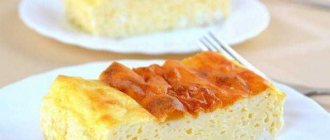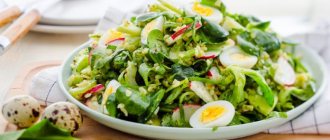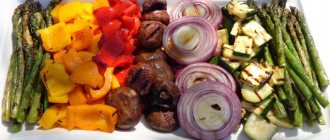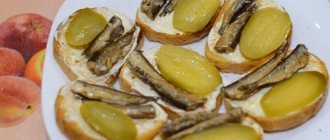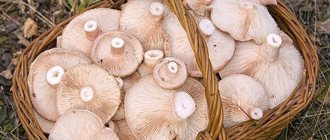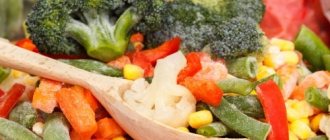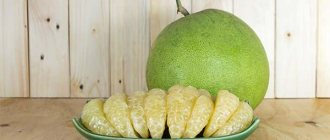The benefits and harms of pickled vegetables
Often, canned vegetables are healthier than fresh ones, since the natural fermentation process almost completely destroys nitrates.
Thanks to the lactic acid formed, vitamins are not only preserved, but also multiplied. With the help of pickled vegetables, we can saturate our body with the vitamins preserved in them, which are so lacking in the winter. If you systematically eat fermented preparations, your immune system will become stronger, your body will be less susceptible to various infections, cholesterol levels will decrease, your intestinal microflora will be cleansed and improved. The brine from pickled vegetables is also beneficial.
However, despite all the benefits, there is also a major harm from eating fermented foods. Due to the increased content of lactic acid, people with stomach ulcers, gastritis, pancreatitis, cholelithiasis, and kidney problems are prohibited from fermented food. Excessive consumption of such products is also not recommended due to the presence of salt, which will contribute to fluid retention in the body, and as a result, the formation of edema and swelling.
Options for preparing pickled eggplants for the winter
We grew a lot of vegetables, including eggplants, but in the fall we didn’t have time to eat them all, so we save them for the long winter so that we can enjoy our favorite dish, for example, at the festive New Year’s table.
Let's start with the simplest method, deep freezing the semi-finished product. Eggplants should be frozen after the third step of the cooking process described above. In winter, after taking vegetables out of the freezer, it is very easy to go through the remaining cooking steps, fortunately there are no problems with carrots and garlic.
It is recommended to defrost the semi-finished product in the refrigerator, and not at room temperature. This way the eggplants won’t lose their shape and won’t become soggy.
Now let’s prepare pickled eggplants stuffed with vegetables for the winter. The recipe is slightly different from the one above.
So, the ingredients are the same, but in this case we will prepare marinade instead of brine. To do this, boil 3 liters of water with the addition of only 2 tbsp. l. salt, bay leaf (5 pcs.) and peppercorns (10 pcs.). In addition, we will not stew the filling; we will use it raw.
Place the already stuffed eggplants tightly in a pan, pour in the chilled marinade and place under pressure for 2 weeks at room temperature. After the appointed time, we try, if they are not sour enough, you can extend the process for another week. Ready eggplants must be stored in the cellar, and in the absence of the latter - in the refrigerator.
For lovers of the traditional method of storing winter preparations, we can recommend rolling up pickled eggplants in jars for the winter. To do this, you will need to sterilize the jars in the usual way, then place the stuffed eggplants in them, pour in the marinade and roll up the lids.
How to ferment cucumbers - recipes
How to ferment cucumbers for the winter correctly? An important step is the selection of fruits. Vegetables should be firm and full-bodied. If there is emptiness, crispy cucumbers will not work. In order for the vegetables to be evenly salted, their size should be approximately the same.
You can preserve cucumbers according to different recipes, each of which differs in both the method of preparation and the set of spices. Using all the methods presented, greens are prepared simply and turn out delicious.
Cucumbers in three-liter jars
To prepare pickled cucumbers, crispy for the winter in 3-liter jars, you will need:
- 2 kg of cucumbers;
- 2 liters of water;
- 20 cloves of garlic;
- 100 grams of salt;
- 3 dill umbrellas;
- Currant, horseradish and oak leaves.
Wash the fruits and trim the ends. Wash and dry the greens. Place ½ of all the greens and garlic on the bottom of the washed jar. Next, place the cucumbers to the top. The fruits should not be pressed too hard to avoid damaging them. Then put garlic on top and cover the greens with the remaining herbs.
Pour salt into the water and stir. Pour cold salted water into a jar of cucumbers, close and put in the refrigerator. During the fermentation process, the brine may spill out, so it is better to put the jar in a container so that the same brine can be poured back. The fruits must be completely submerged in water. You can taste pickled cucumbers only after 2 months.
Cooking hot
This method can be called lazy preservation. Minimum time and ingredients required:
- Cucumbers – 0.5 kg;
- Water – 500 ml;
- Salt – 15 g;
- 4 garlic cloves;
- Dill umbrellas or dried dill.
Peel the garlic and cut each clove lengthwise. Pour dill into the bottom of a liter jar and add garlic. The amount of garlic can be adjusted to your taste, depending on how spicy you want to give the appetizer.
Place the washed fruits with cut off butts tightly in a jar. Bring water to a boil and stir salt in it. Pour the prepared hot brine over the greens. They must be completely covered with it. Close the lid and leave for a day at room temperature. Cooking may be extended by 10 hours if the room is cool.
Despite the fact that this method is very simple, the cucumbers turn out crispy and very tasty, the taste does not lag behind longer pickling.
How to do it cold
We ferment cucumbers for the winter in a cold way according to the classic recipe: soak 2 kg of cucumbers for several hours.
In the meantime, the jars are sterilized. The horseradish leaf will go into the jar first, followed by dried dill, bay leaf, peppercorns, garlic, and lastly, soaked cucumbers.
Dissolve salt in cold water and pour into a jar of vegetables. Leave to ferment for 3 days in a dark place, but the temperature should be at room temperature. After this time, the jars can be rolled up or the nylon lid may remain, and then put into the cold.
Cold brine has several priorities over hot brine: the cooking process is faster and easier, you don’t have to waste time boiling water. In addition, cucumber in cold water retains more useful substances than in boiling water.
Canning with horseradish
Cucumbers fermented in jars for the winter with horseradish turn out piquant and truly crispy.
- Green fruits – 4 kg;
- Horseradish root – 300 g;
- horseradish leaves – 5 pcs.;
- dill umbrellas – 5 pcs.;
- garlic - head;
- laurel leaves;
- peppercorns;
- capsicum red pepper – 3-5 pcs.;
- Salt – 50 g per 1 liter of water;
- Cherry and currant leaves.
We begin canning by soaking the fruits for several hours.
The water should completely saturate them. Wash and dry all green leaves. Peel the garlic and divide each clove into 2 halves. Chop the horseradish root loosely, but thinly. Place horseradish root and leaf, a few peppercorns, bay leaves, hot pepper, pickling leaves and dill into washed jars.
Next, tightly pack the greens into the jars and cover with a horseradish leaf. Time to make the first brine: dissolve 150 grams of salt in three liters of water and fill the jars with the vegetable mixture. Make several holes in the nylon lids and close the jars.
Fermentation lasts about a week at room conditions. After which, all the contents are taken out, each jar is washed, the horseradish root, hot peppers and cucumbers are washed and placed in a clean jar.
We prepare a new brine, calculating 1.5 tablespoons of salt for each liter of water. We fill the jars with it, close the lids and store the fermented product in a cold place.
A la barrel cucumbers for rolling
This recipe contains an ingredient such as dry mustard, which will give the dish an invigorating taste. Pickled cucumbers with mustard for the winter are prepared from the following products:
- A kilogram of cucumbers;
- Liter of water;
- 50 g salt;
- A couple of cloves of garlic;
- Dry mustard – 1 tbsp. l.;
- Horseradish leaves and root;
- Dill umbrellas;
- Laurel leaves;
- Peppercorns;
- carnation;
- leaves for pickles (oak, currant, cherry).
Peel the garlic and cut into thin slices.
Grate the horseradish root. Wash the cucumbers and remove the butts. We will use boiled but cooled water. Therefore, while the pot of water is on the stove, you need to wash the cans of soda.
When the jars are ready, we begin to place: first half of all the greens, and then cucumbers, spices, horseradish root and garlic. Don’t forget to salt the cooled boiled water, then fill the jars with it, but not all the way to the neck. Add the last layer of mustard powder and roll it up with an iron lid. Pickled cucumber will be ready in 3-5 days, and will taste exactly like barrel cucumber.
Cucumbers pickled in jars with mustard are stored in the cellar after fermentation.
Kvasim with honey
This recipe for pickled cucumbers for the winter will delight you with an unusual honey aroma combined with garlic. The preparation will be sweet and sour and a little spicy.
- Zelentsy – 2 kg;
- Water – 1.5 l;
- Dill inflorescences – 2 pcs.;
- Horseradish and cherry leaves;
- Garlic – 3 cloves;
- Honey – 50 g;
- Hot pepper – 2 pcs.;
- Vinegar – ½ faceted glass;
- Salt – 2 tbsp. l.
Place the cucumbers in a bucket and cover with cold water for several hours.
Meanwhile, wash the jars and leave the glass to drain excess moisture. We wash the leaves for pickles, dill inflorescences and peppers. Place the spices in jars. Next, place the cucumbers, starting with large fruits. Place smaller ones closer to the neck of the container.
Let's boil water and fill the jars with boiling water. After 10 minutes, pour the water into the pan and boil again. Refill the jars with boiling water for another 10 minutes. We use the same water, since it has already been saturated with the aroma of spices from the jars. Drain the water again and boil it a third time.
The last step is to put peeled garlic, salt, vinegar and honey into the jars and fill them with boiling water, after which the jars are preserved. As soon as the capping is completed, cover the containers with vegetables with a warm blanket for 4 hours.
How to make pickled cucumbers in liter jars
Don't want to use large volumes? Then this simple recipe is for you, where you will need a one-liter jar. Pickling is prepared from ingredients such as:
- Cucumbers – 1 kg;
- Garlic – 2 cloves;
- Dill;
- Cherry, currant and horseradish leaves;
- Salt – 50 g;
- Water – 1 l.
Soak the cucumbers in cold water for 5 hours. Prepare a container, peel the garlic, cut into slices. Wash and dry the greens.
Place leaves for pickling, slices of garlic and dill in a jar. Next, add the cucumbers. Mix salt in filtered water and fill our liter tank with cucumbers with the resulting liquid. Close the jar with a lid and leave at room temperature until it swells. After that, we will ferment the cucumbers uncovered for 12 hours. Next, close the jar again and store it in the refrigerator. Pickling in this form can last the entire winter period.
Kvasim cucumbers for storing jars in the apartment
Both a jar and a barrel can be used to ferment cucumbers.
There is debate over which method is more delicious. If the cooking algorithm is correct in both cases, then the taste of canned and barreled ones will be the same. The point is storage, barrel cucumbers are stored in a barrel or metal container, with jar cucumbers it is easier for apartment conditions and they last longer. For a three-liter jar for apartment cucumbers you will need:
- The fruits are small in size;
- Branches with celery leaves;
- Garlic;
- Hot pepper (green);
- Dill umbrellas;
- Laurel leaves;
- Carnation buds;
- Mustard seed.
Place garlic, dill, pepper, and bay leaves into prepared jars. Next, put the cucumbers, adding greens to the layers. There is no need to chop the greens. Make a salty brine by diluting 150 grams of salt in water for each jar. Pour the resulting liquid over the vegetables and cover with a lid. Place the jars in a container, as liquid may leak out. Leave the cucumbers in this form on the kitchen table for about a week.
Foam will form during the process and this is normal. At the end of fermentation, put gauze on the jar and strain the brine through it into a saucepan, which we immediately bring to a boil.
Remove everything from the jar and rinse them. From the contents we will need cucumbers, hot peppers and garlic, which we also wash under running water. Place the clean ingredients back into clean jars. Pour boiling brine over it for 15 minutes. Drain the liquid and send it to boil. In the meantime, add cloves and a teaspoon of mustard seed to the cucumber jars. Pour boiling brine and seal the jars.
Grandmother's sourdough method
Let's consider the old, grandmother's method of pickling cucumbers.
A time-tested recipe, the cucumbers will not be too salty and will have an excellent crunch. First, let's start fermenting the cucumbers in a saucepan: to do this, add dill inflorescences, cherry and horseradish leaves, garlic cloves, and chili peppers, previously cut into several parts. Lastly, add the cucumbers.
Dilute 150 grams of salt in three liters of water and pour the resulting brine into a pan with vegetables. Cover with a plate and place the weight. How long to ferment cucumbers will depend on the temperature in your room. It will take approximately 5 to 7 days.
During this time, you should prepare jars with lids and boil water. We will use cold but boiled water for preservation. Remove the cucumbers from the pan and rinse thoroughly. Place in jars, fill with prepared water and roll up. This product should be stored away from heat.
Required Ingredients
For cooking we will need the following products (the quantity is calculated for 1 kg of eggplant):
On this topic:
Now you know the most delicious recipe for soaked apples in jars
Jun 19, 2020
Sun-dried tomatoes in the oven for the winter - recipes and tips
Jun 5, 2020
BACK FORWARD 1 of 61
- eggplants themselves (by the way, they are also called “little blue”);
- 2 - 3 pcs. carrots;
- about 100 g of spicy roots, which we talked about above;
- if you decide to add tomatoes, then a couple of medium-sized ones are enough;
- 1 head of garlic (optional), it is generally recommended to prepare pickled eggplants with garlic for the winter, because this vegetable helps strengthen the immune system during the snowy season;
- It's a matter of spices, you will need 1 tsp. ground black pepper or 1 pod of hot pepper, 1 tbsp. l. ground paprika and a little parsley;
- you need salt, to boil eggplants you need 2 tbsp. l. for 2 liters of water, and for brine - 3 tbsp. l. for 1 l;
- A few stalks of parsley will be useful for tying together already stuffed eggplants, as well as dill inflorescences and a bay leaf for pickling.
Why do cucumbers become soft?
There are cases when, after fermentation, the fruits soften, which spoils the taste of the product. This can happen if the cucumbers or canning utensils have not been washed properly. And the resulting mold spoiled the product.
Or the workpiece was in a room with a high temperature, and the fruits were simply cooked.
The use of iodized salt can also be a reason for soft fruits. It is not at all suitable for conservation. The softening of the fruit can be affected not only by the type of salt, but also by how much it was added, namely insufficient salting.
If the cucumbers were not soaked before fermenting, they may also come out soft.
Useful tips
- A quality choice of vegetable is half the success of fermentation.
- Both the cucumbers and the starter container should be washed thoroughly.
- For preservation, use only coarse rock salt.
- To prevent pickled cucumbers from turning out soft, they must be prepared using oak, currant and cherry leaves. This is what gives it strength.
- Using horseradish will prevent the formation of mold and spoilage of the product.
To make winter enjoyable with delicious preparations, follow the fermentation technology, follow the recipes and do not overdo it with spices.
Vegetables pickled in a barrel for the winter
Tired of salting and fermenting vegetables in jars? You can always prepare them in a barrel. And for this it is not necessary to use a huge container from ancient Russian fairy tales. At almost any hardware market you can buy a plastic barrel in which pickled vegetables will turn out just as good.
Ingredients:
- cucumbers
- zucchini
- tomatoes
- White cabbage
- sour apples
- dill
- add horseradish and black currant leaves as desired
- garlic
It is not necessary to salt vegetables in a real barrel, you can buy a plastic one
Preparation:
- The amount of vegetables depends on the size of the container used (everything should be in equal proportions, with the exception of garlic, a couple of heads are enough).
- Place horseradish leaves, currants and dill inflorescences in a solid layer on the bottom of the container.
- Next, start layering vegetables: hard ones on the bottom, softer ones on top.
- Each layer must be covered with a layer of leaves and greenery so that the vegetables do not come into contact with each other.
- Make a brine using 45 g of salt per liter of distilled water. Add salt to cold water until it is completely dissolved.
- Pour the resulting brine over the workpiece, cover everything on top with several layers of gauze cloth and place a heavy object on top.
Store the container in a cool, dark place, changing the gauze cloth once a day. In two weeks the pickling will be ready.
